Highly Transparent Yb:Y2O3 Laser Ceramics with High Thermal Conductivity Obtained via a Sintering-Additive-Free Strategy
Abstract
1. Introduction
2. Results and Discussion
2.1. Powder Phase and Morphology
2.2. Dispersion Behavior of Yb3+-Doped Y2O3 Powders
2.3. Morphology, Optical, Mechanical, Thermal, and Laser Properties of Yb3+-Doped Y2O3 Transparent Ceramics
3. Materials and Methods
3.1. Powder Preparation
3.2. Suspension Preparation
3.3. Consolidation and Sintering
3.4. Characterization
4. Conclusions
Author Contributions
Funding
Institutional Review Board Statement
Informed Consent Statement
Data Availability Statement
Acknowledgments
Conflicts of Interest
References
- Liu, Z.Y.; Ikesue, A.; Li, J. Research progress and prospects of rare-earth doped sesquioxide laser ceramics. J. Eur. Ceram. Soc. 2021, 41, 3895–3910. [Google Scholar] [CrossRef]
- Yang, C.L.; Huang, J.Q.; Huang, Q.F.; Deng, Z.H.; Wang, Y.; Li, X.Y.; Zhou, Z.H.; Chen, J.; Liu, Z.G.; Guo, W. Optical, thermal, and mechanical properties of (Y1−xScx)2O3 transparent ceramics. J. Adv. Ceram. 2022, 11, 901–911. [Google Scholar] [CrossRef]
- Brecher, C.; Wei, G.C.; Rhodes, W.H. Point defects in optical ceramics: High temperature absorption processes in lanthana-strengthened yttria. J. Am. Ceram. Soc. 1990, 73, 1473–1488. [Google Scholar] [CrossRef]
- Zhang, L.; Pan, W.; Feng, J. Dependence of spectroscopic and thermal properties on concentration and temperature for Yb:Y2O3 transparent ceramics. J. Eur. Ceram. Soc. 2015, 35, 2547–2554. [Google Scholar] [CrossRef]
- Takaichi, K.; Yagi, H.; Shirakawa, A.; Ueda, K.; Hosokawa, S.; Yanagitani, T.; Kaminskii, A.A. Lu2O3:Yb3+ ceramics—a novel gain material for high-power solid-state lasers. Phys. Status Solidi 2005, 202, R1–R3. [Google Scholar] [CrossRef]
- Wang, X.L.; Shi, Y.L.; Lu, Z.H.; Zhang, C.; Chen, R.C.; Qi, J.Q.; Lu, T.C. Distinguishing the effects of lattice Gd3+ and segregated Gd3+ on optical properties of Yb:GdYAG transparent ceramics. J. Eur. Ceram. Soc. 2024, 44, 116722. [Google Scholar] [CrossRef]
- Pirri, A.; Toci, G.; Patrizi, B.; Vannini, M. An overview on Yb-doped transparent polycrystalline sesquioxide laser ceramics. IEEE J. Sel. Top. Quant. Electron. 2018, 24, 1602108. [Google Scholar] [CrossRef]
- Hou, X.R.; Zhou, S.M.; Li, Y.K.; Li, W.J. Effect of ZrO2 on the sinterability and spectral properties of (Yb0.05Y0.95)2O3 transparent ceramic. Opt. Mater. 2010, 32, 920–923. [Google Scholar] [CrossRef]
- Kong, J.; Tang, D.Y.; Lu, J.; Ueda, K.; Yagi, H.; Yanagitani, T. Diode-end-pumped 4.2- W continuous-wave Yb:Y2O3 ceramic laser. Opt. Lett. 2004, 29, 1212–1214. [Google Scholar] [CrossRef]
- Shirakawa, A.; Takaichi, K.; Yagi, H.; Bisson, J.-F.; Lu, J.; Musha, M.; Ueda, K.; Yanagitani, T.; Petrov, T.S.; Kaminski, A.A. Diode-pumped mode-locked Yb3+:Y2O3 ceramic laser. Optic Express 2003, 11, 2911–2916. [Google Scholar] [CrossRef]
- David, S.P.; Jambunathan, V.; Yue, F.; Lucianetti, A.; Mocek, T. Efficient diode pumped Yb:Y2O3 cryogenic laser. Appl. Phys. B 2019, 125, 137. [Google Scholar] [CrossRef]
- Vorona, I.O.; Yavetskiy, R.P.; Doroshenko, A.G.; Parkhomenko, S.V.; Baumer, V.N.; Tolmachev, A.V.; Kosyanov, D.Y.; Vovna, V.I.; Kuryavyi, V.G.; Greculeasa, M.; et al. Structural-phase state and lasing of 5-15 at% Yb3+:Y3Al5O12 optical ceramics. J. Eur. Ceram. Soc. 2017, 37, 4115–4122. [Google Scholar] [CrossRef]
- Zhang, X.; Huang, X.Y.; Liu, Z.Y.; Feng, Y.G.; Jiang, N.; Wu, L.X.; Yang, Z.X.; Xie, T.F.; Li, J. Fabrication, microstructure and properties of transparent Yb:Y2O3 ceramics from co-precipitated nanopowders. Opt. Mater. 2021, 122, 111792. [Google Scholar] [CrossRef]
- Li, Q.; Wang, J.; Ma, J.; Ni, M.; Yang, F.; Liu, P.; Lee, K.Y.; Hsiang, H.-I.; Shen, D.Y.; Tang, D.Y. Fabrication of high-efficiency Yb:Y2O3 laser ceramics without photodarkening. J. Am. Ceram. Soc. 2022, 105, 3375–3381. [Google Scholar] [CrossRef]
- Balabanov, S.; Permin, D.; Evstropov, T.; Andreev, P.; Basyrova, L.; Camy, P.; Baranov, M.; Mateos, X.; Loiko, P. Hot pressing of Yb:Y2O3 laser ceramics with LiF sintering aid. Opt. Mater. 2021, 119, 111349. [Google Scholar] [CrossRef]
- Wang, J.; Ma, J.; Zhang, J.; Liu, P.; Luo, D.W.; Yin, D.L.; Tang, D.Y.; Kong, L.B. Yb:Y2O3 transparent ceramics processed with hot isostatic pressing. Opt. Mater. 2017, 71, 117–120. [Google Scholar] [CrossRef]
- Lange, F.F. Powder processing science and technology for increased reliability. J. Am. Ceram. Soc. 1989, 72, 3–15. [Google Scholar] [CrossRef]
- Olhero, S.M.; Ganesh, I.; Torres, P.M.C.; Alves, F.J.; Ferreira, J.M.F. Aqueous colloidal processing of ZTA composites. J. Am. Ceram. Soc. 2009, 92, 9–16. [Google Scholar] [CrossRef]
- Lewis, J.A. Colloidal processing of ceramics. J. Am. Ceram. Soc. 2000, 83, 2341–2359. [Google Scholar] [CrossRef]
- Yasrebi, M.; Zimek-Moroz, M.; Kemp, W.; Sturgis, D.H. Role of particle dissolution in stability of binary yttria-silica colloidal suspensions. J. Am. Ceram. Soc. 1996, 79, 1223–1227. [Google Scholar] [CrossRef]
- Kuroda, Y.; Hamano, H.; Mori, T.; Yoshikawa, Y.; Nagao, M. Specific adsorption behavior of water on a Y2O3 surface. Langmuir 2000, 16, 6937–6947. [Google Scholar] [CrossRef]
- Jin, L.L.; Mao, X.J.; Wang, S.W.; Dong, M.J. Optimization of the rheological properties of yttria suspensions. Ceram. Int. 2009, 35, 925–927. [Google Scholar] [CrossRef]
- Sun, Z.Q.; Zhu, X.W.; Li, M.S.; Zhou, Y.C.; Sakka, Y. Hydrolysis and dispersion properties of aqueous Y2Si2O7 suspensions. J. Am. Ceram. Soc. 2009, 92, 54–61. [Google Scholar] [CrossRef]
- Ning, K.J.; Wang, J.; Luo, D.W.; Dong, Z.L.; Kong, L.B.; Tan, D.Y. Low-level sintering aids for highly transparent Yb:Y2O3 ceramics. J. Alloys. Compd. 2017, 695, 1414–1419. [Google Scholar] [CrossRef]
- Yavetskiy, R.P.; Balabanov, A.E.; Parkhomenko, S.V.; Kryzhanovska, O.S.; Doroshenko, A.G.; Mateychenko, P.V.; Tolmachev, A.V.; Li, J.; Jiang, N.; Gheorghe, L.; et al. Effect of starting materials and sintering temperature on microstructure and optical properties of Y2O3:Yb3+ 5 at% transparent ceramics. J. Adv. Ceram. 2020, 9, 49–61. [Google Scholar] [CrossRef]
- Ning, K.J.; Wang, J.; Ma, J.; Dong, Z.L.; Kong, L.B.; Tang, D.Y. Fabrication of laser grade Yb: Y2O3 transparent ceramics with ZrO2 additive through hot isostatic pressing. Mater. Today Commun. 2020, 24, 101185. [Google Scholar] [CrossRef]
- Hou, X.R.; Zhou, S.M.; Jia, T.T.; Lin, H.; Teng, H. Structural, thermal and mechanical properties of transparent Yb:(Y0.97Zr0.03)2O3 ceramic. J. Eur. Ceram. Soc. 2011, 31, 733–738. [Google Scholar] [CrossRef]
- Hou, X.R.; Zhou, S.M.; Li, W.J.; Li, Y.K. Study on the effect and mechanism of zirconia on the sinterability of yttria transparent ceramic. J. Eur. Ceram. Soc. 2010, 30, 3125–3129. [Google Scholar] [CrossRef]
- Yoshida, H.; Kodo, M.; Soga, K.; Yamamoto, T. Doping effect on sinterability of polycrystalline yttria: From the viewpoint of cation diffusivity. J. Eur. Ceram. Soc. 2012, 32, 3103–3114. [Google Scholar] [CrossRef]
- Bernard-Granger, G.; Guizard, C. Sintering behavior and optical properties of yttria. J. Am. Ceram. Soc. 2007, 90, 2698–2702. [Google Scholar] [CrossRef]
- Xu, X.D.; Zhao, Z.W.; Xu, J.; Deng, P.Z. Thermal diffusivity, conductivity and expansion of Yb3xY3(1–x)Al5O12 (x = 0.05, 0.1 and 0.25) single crystals. Solid. State Commun. 2004, 130, 529–532. [Google Scholar] [CrossRef]
- Wang, J.; Yin, D.L.; Ma, J.; Liu, P.; Wang, Y.; Dong, Z.L.; Kong, L.B.; Tang, D.Y. Pump laser induced photodarkening in ZrO2-doped Yb:Y2O3 laser ceramics. J. Eur. Ceram. Soc. 2019, 39, 635–640. [Google Scholar] [CrossRef]
- Stanciua, G.; Gheorghea, L.; Voicua, F.; Haua, S.; Gheorghea, C.; Croitorua, G.; Enculescub, M.; Yavetskiy, R.P. Highly transparent Yb:Y2O3 ceramics obtained by solid-state reaction and combined sintering procedures. Ceram. Int. 2019, 45, 3217–3222. [Google Scholar] [CrossRef]
- Liu, L.K.; Zhu, Q.H.; Zhu, Q.Q.; Jiang, B.X.; Feng, M.H.; Zhang, L. Fabrication of fine-grained undoped Y2O3 transparent ceramic using nitrate pyrogenation synthesized nanopowders. Ceram. Int. 2019, 45, 5339–5345. [Google Scholar] [CrossRef]
- Fu, Z.C.; Li, X.D.; Zhang, M.; Zhu, Q.; Li, J.G.; He, J.; Wang, X.A.; Sun, X.D. Achieving fabrication of highly transparent Y2O3 ceramics via air pre-sintering by deionization treatment of suspension. J. Am. Ceram. Soc. 2021, 104, 2689–2701. [Google Scholar] [CrossRef]
- Maruyama, M.; Okada, H.; Ochi, Y.; Nagashima, K. Sub-picosecond regenerative amplifier of Yb-doped Y2O3 ceramic thin disk. Opt. Express 2016, 24, 1685–1692. [Google Scholar] [CrossRef]
- Yu, J.L.; Yang, J.L.; Huang, Y. The transformation mechanism from suspension to green body and the development of colloidal forming. Ceram. Int. 2011, 37, 1435–1451. [Google Scholar] [CrossRef]
- Muller, R.H.; Mader, K.; Gohla, S. Solid lipid nanoparticles (SLN) for controlled drug delivery—A review of the state of the art. Eur. J. Pharm. Biopharm. 2000, 50, 161–177. [Google Scholar] [CrossRef]
- Gouy, M. Sur la constitution de la charge électrique à la surface d’un electrolyte. J. Phys. Theor. Appl. 1910, 9, 457–468. [Google Scholar] [CrossRef]
- Chapman, D.L. A contribution to the theory of electrocapillarity. Lond. Edinb. Dublin Philos. Mag. J. Sci. 1913, 25, 475–481. [Google Scholar] [CrossRef]
- Saboorian-Jooybari, H.; Chen, Z. Calculation of re-defined electrical double layer thickness in symmetrical electrolyte solutions. Results. Phys. 2019, 15, 102501. [Google Scholar] [CrossRef]
- Mondal, M.; Rai, V.K.; Srivastava, C.; Sarkar, S.; Akash, R. Enhanced frequency upconversion in Ho3+/Yb3+/Li+:YMoO4 nanophosphors for photonic and security ink applications. J. Appl. Phys. 2016, 120, 233101.1-11. [Google Scholar] [CrossRef]
- Sanghera, J.; Kim, W.; Villalobos, G.; Shaw, B.; Baker, C.; Frantz, J.; Sadowski, B.; Aggarwal, I. Ceramic laser materials. Materials 2012, 5, 258–277. [Google Scholar] [CrossRef] [PubMed]
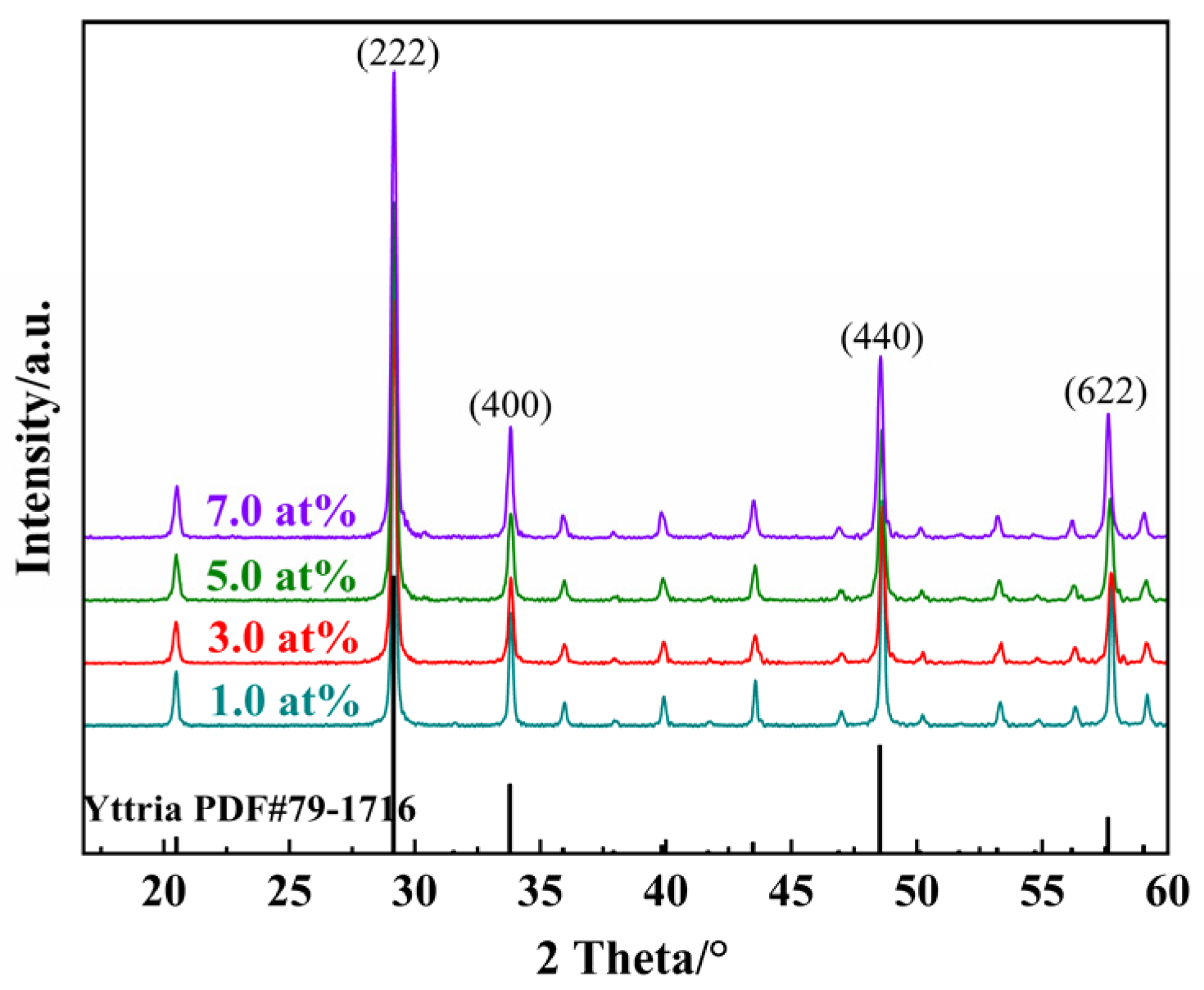
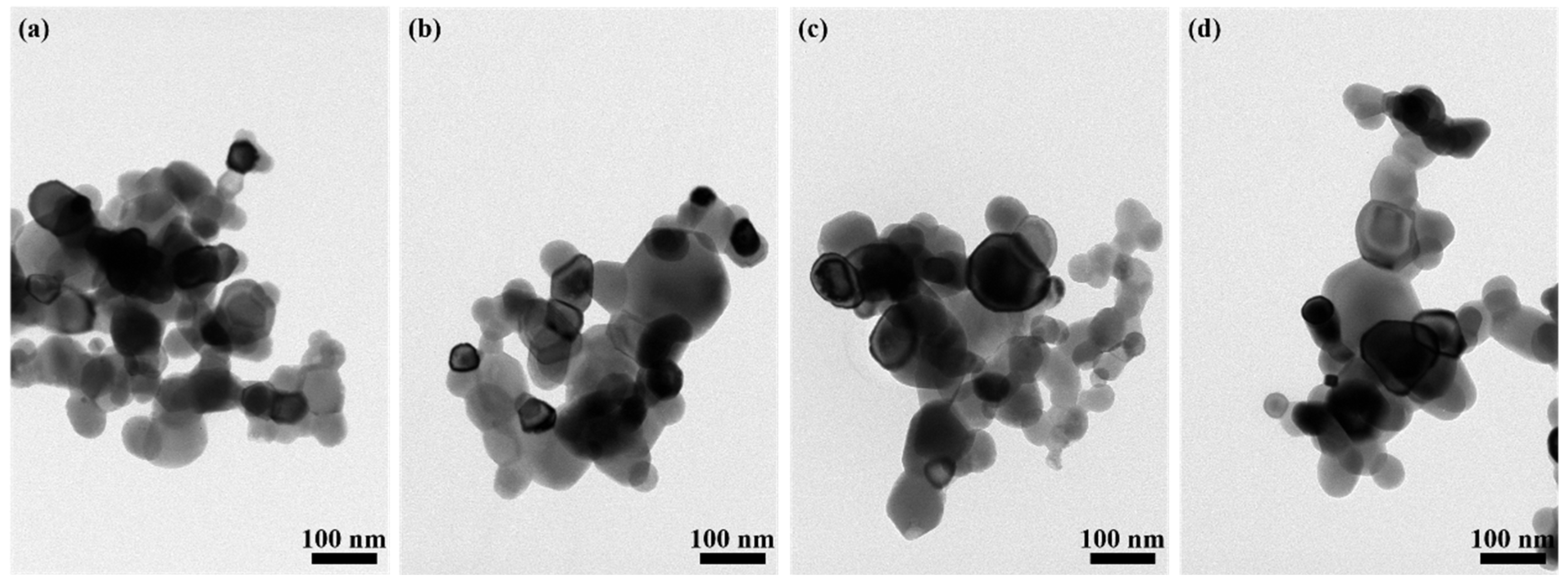
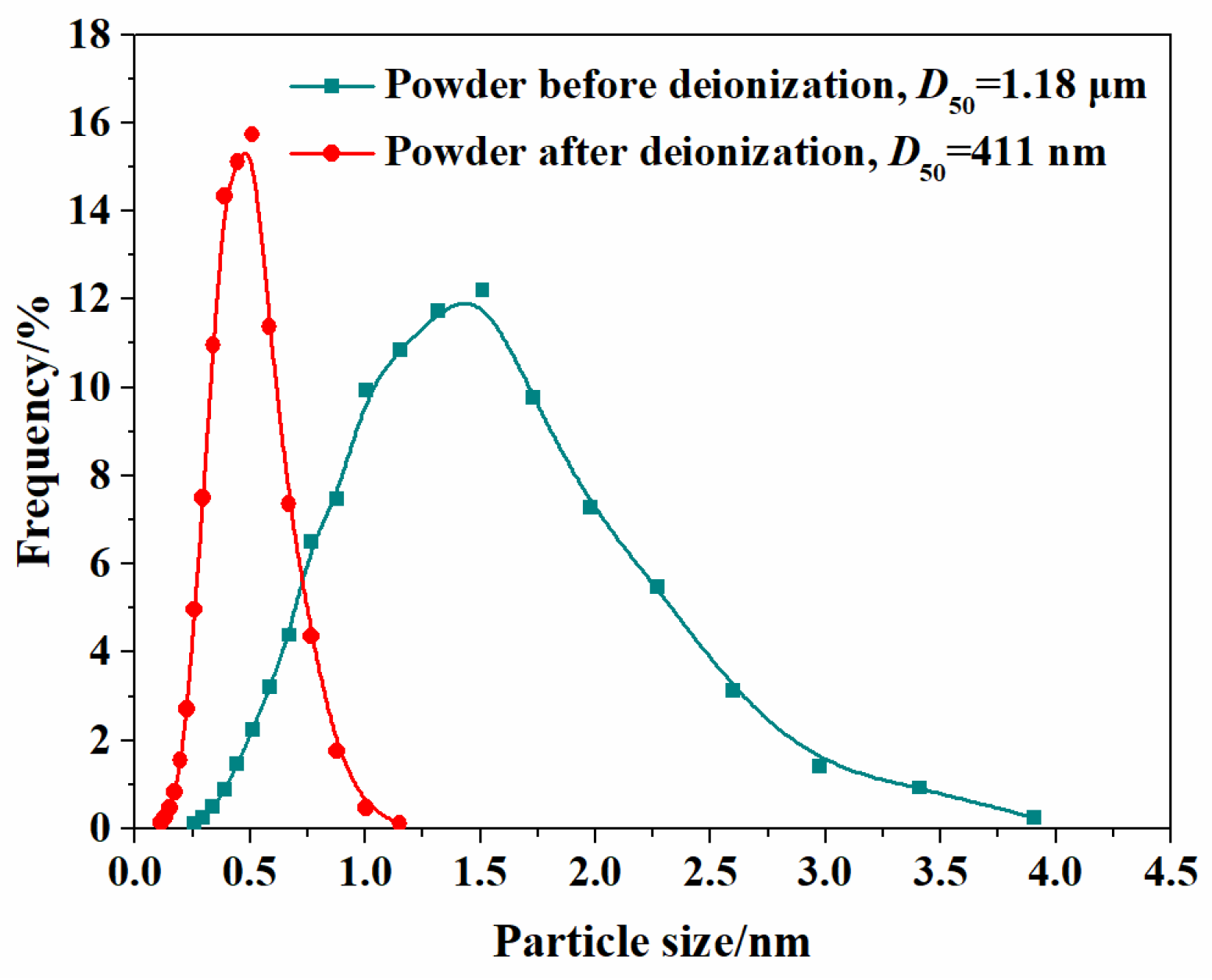
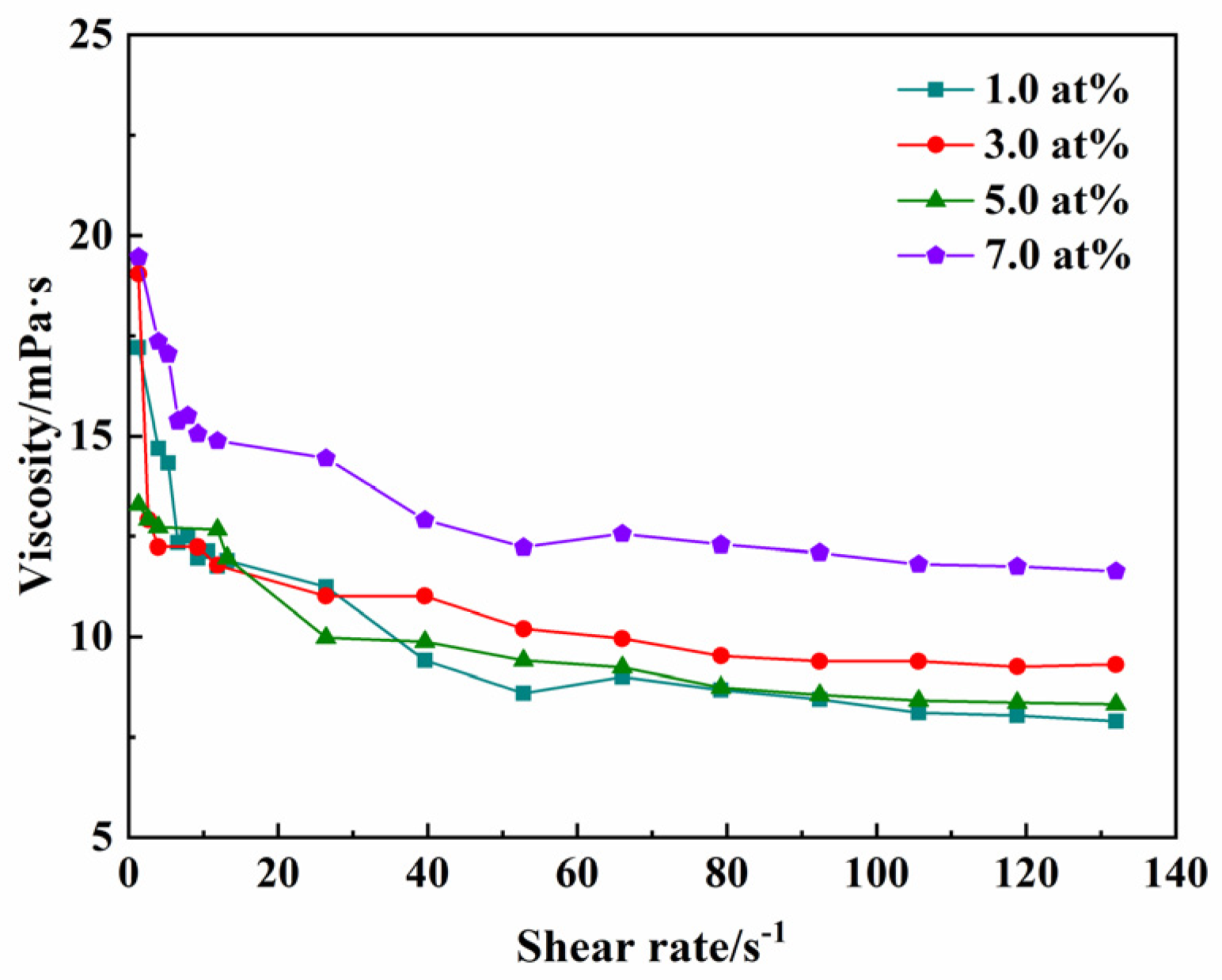
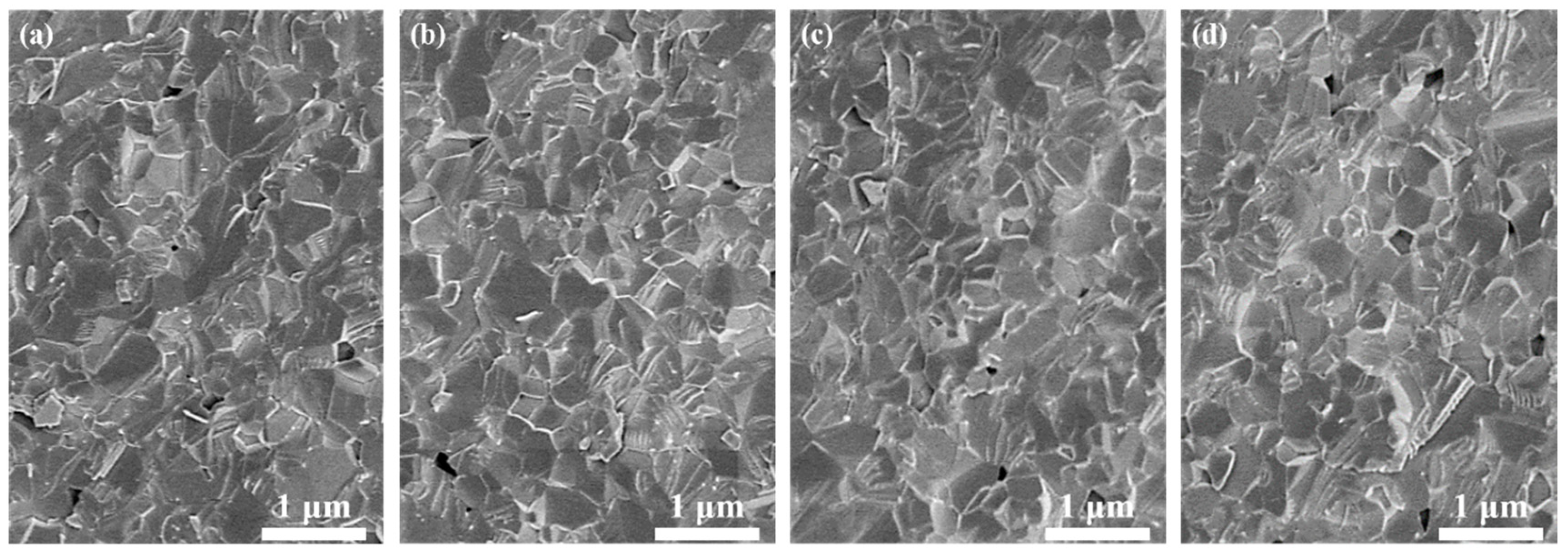

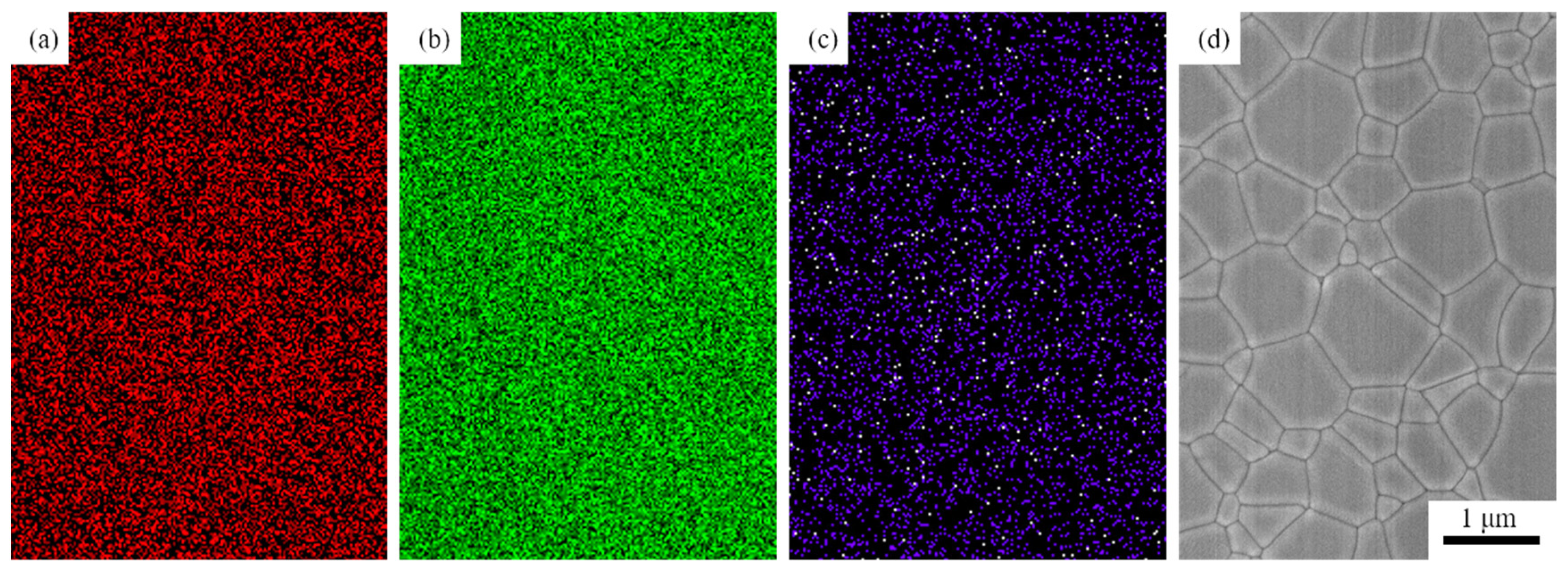

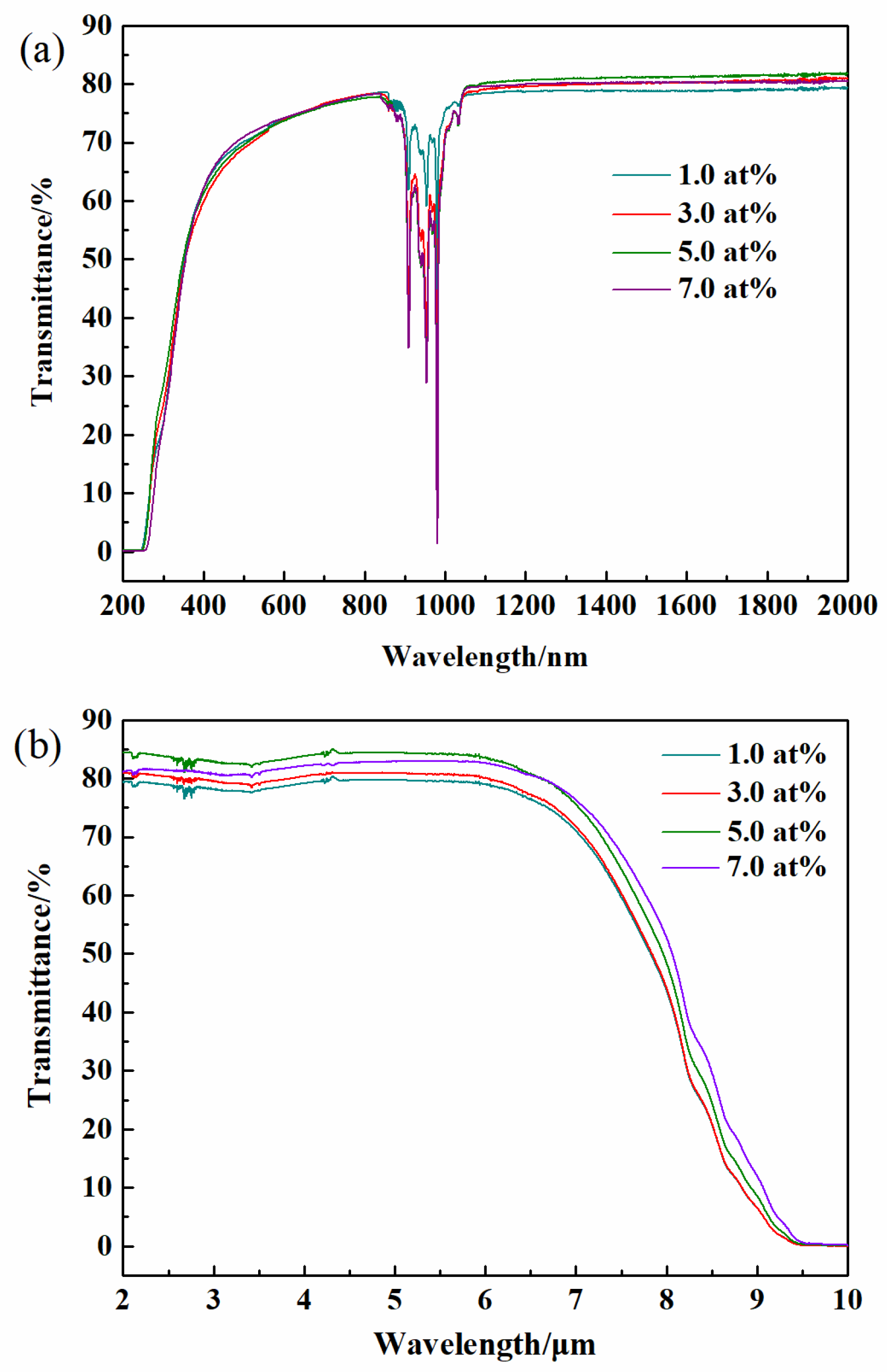
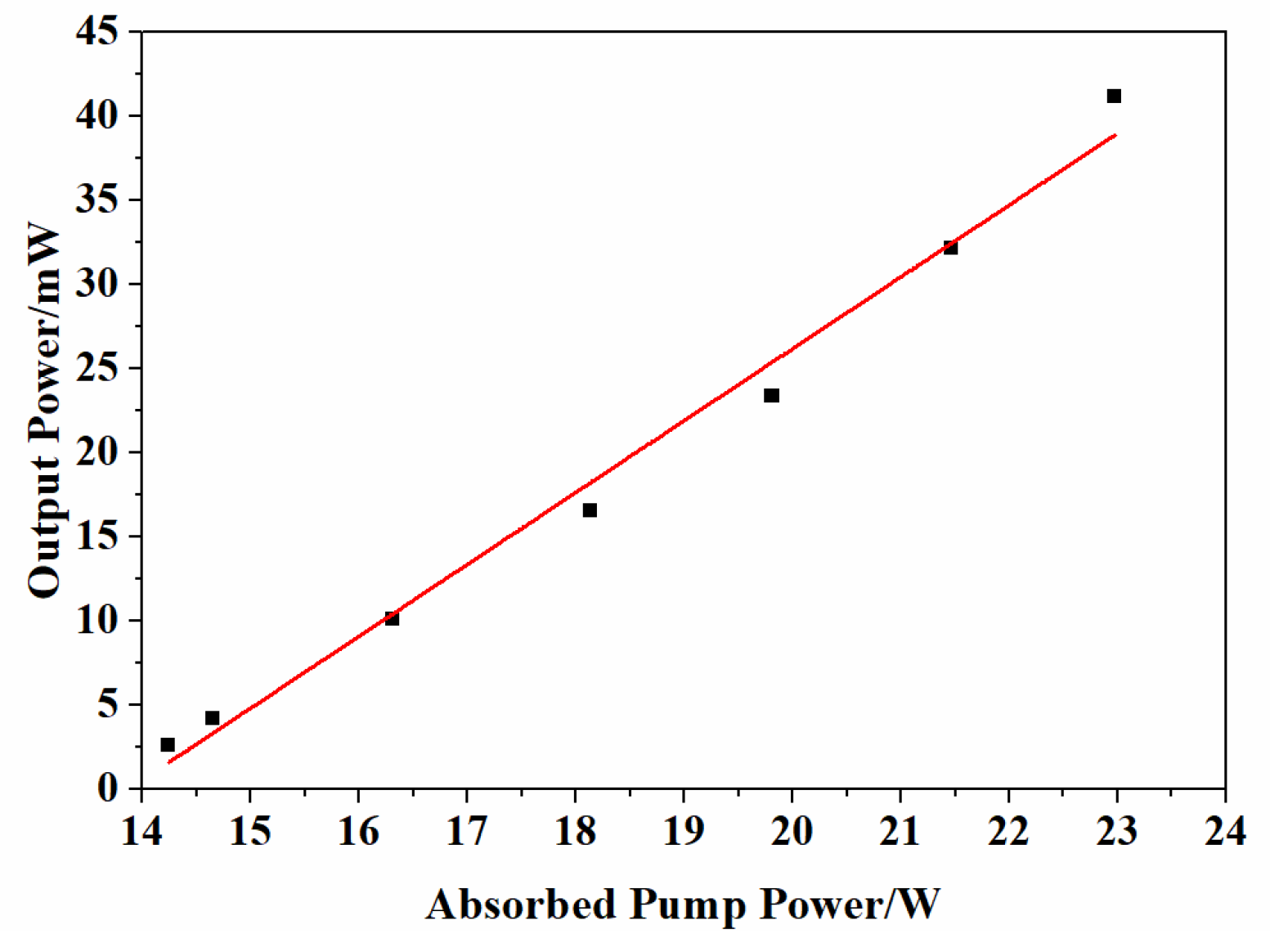
| Concentration of Yb3+ (at%) | Average Grain Size (nm) | Microhardness (GPa) | Fracture Toughness, KIC (MPa∙m1/2) |
|---|---|---|---|
| 0.0 [35] | 690 ± 20 | 8.36 ± 0.03 | 1.01 ± 0.02 |
| 1.0 | 701 ± 24 | 8.22 ± 0.06 | 1.00 ± 0.03 |
| 3.0 | 722 ± 22 | 8.20 ± 0.05 | 0.99 ± 0.05 |
| 5.0 | 752 ± 25 | 8.13 ± 0.07 | 0.98 ± 0.05 |
| 7.0 | 761 ± 19 | 8.10 ± 0.03 | 0.99 ± 0.05 |
| Sample | Synthesis of Powder | Consolidation | Sintering | Additives | Thermal Conductivity at RT (W·m−1·K−1) |
|---|---|---|---|---|---|
| 5.0 at% Yb:Y2O3 [4] | solid-state reaction | dry pressing | vacuum sintering | 3.0 at% ZrO2 + 9.0 at% La2O3 | 6.50 |
| 5.0 at% Yb:Y2O3 [27] | solid-state reaction | dry pressing | vacuum sintering | 3.0 at% ZrO2 | 6.46 |
| 5.0 at% Yb:Y2O3 [16] | co-precipitation | dry pressing | vacuum sintering + HIP | 1.0 at% ZrO2 | 8.84 |
| 5.0 at% Yb:Y2O3 (This work) | solid-state reaction | centrifugal casting | air pre-sintering + HIP | none | 9.94 |
Disclaimer/Publisher’s Note: The statements, opinions and data contained in all publications are solely those of the individual author(s) and contributor(s) and not of MDPI and/or the editor(s). MDPI and/or the editor(s) disclaim responsibility for any injury to people or property resulting from any ideas, methods, instructions or products referred to in the content. |
© 2025 by the authors. Licensee MDPI, Basel, Switzerland. This article is an open access article distributed under the terms and conditions of the Creative Commons Attribution (CC BY) license (https://creativecommons.org/licenses/by/4.0/).
Share and Cite
Fu, Z.; Wu, Q.; Wu, N.; Long, H.; Li, J.; Ren, Y.; Hou, Z. Highly Transparent Yb:Y2O3 Laser Ceramics with High Thermal Conductivity Obtained via a Sintering-Additive-Free Strategy. Inorganics 2025, 13, 217. https://doi.org/10.3390/inorganics13070217
Fu Z, Wu Q, Wu N, Long H, Li J, Ren Y, Hou Z. Highly Transparent Yb:Y2O3 Laser Ceramics with High Thermal Conductivity Obtained via a Sintering-Additive-Free Strategy. Inorganics. 2025; 13(7):217. https://doi.org/10.3390/inorganics13070217
Chicago/Turabian StyleFu, Zhongchao, Qiang Wu, Nan Wu, Haibo Long, Jinsheng Li, Yi Ren, and Zhaoxia Hou. 2025. "Highly Transparent Yb:Y2O3 Laser Ceramics with High Thermal Conductivity Obtained via a Sintering-Additive-Free Strategy" Inorganics 13, no. 7: 217. https://doi.org/10.3390/inorganics13070217
APA StyleFu, Z., Wu, Q., Wu, N., Long, H., Li, J., Ren, Y., & Hou, Z. (2025). Highly Transparent Yb:Y2O3 Laser Ceramics with High Thermal Conductivity Obtained via a Sintering-Additive-Free Strategy. Inorganics, 13(7), 217. https://doi.org/10.3390/inorganics13070217






